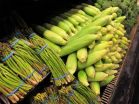(Press-News.org) (Santa Barbara, Calif.) –– Thanks to studies of a fish that gives birth to live young and is not fished commercially, scientists at UC Santa Barbara have discovered that food availability is a critical limiting factor in the health of fish populations.
The scientists were able to attach numbers to this idea, based on 16 years of data. They discovered that the availability of enough food can drive up to a 10-fold increase in the per capita birthrate of fish. And, with adequate food, the young are up to 10 times more likely to survive than those without it.
This research, published this week in the Proceedings of the Royal Society B, is expected to be useful for managers involved in maintaining sustainable fisheries.
The scientists used a remarkable set of black surfperch population data –– collected from 1993 to 2008 –– to develop these statistics. Divers collected the data by monitoring a fish population off Santa Cruz Island, near Santa Barbara. Russell J. Schmitt and Sally J. Holbrook, both professors in UCSB's Department of Ecology, Evolution, and Marine Biology and UCSB's Marine Science Institute, head the team of scientists.
First author Daniel K. Okamoto, a Ph.D. student in UCSB's Department of Ecology, Evolution, and Marine Biology, explained that there has been a lack of information about how survival and birthrates are influenced by food availability, which is known to fluctuate through time. Black surfperch, found off the Pacific Coast from central Baja California northward to Fort Bragg, feed on small crustaceans and worms.
"If a management procedure has called for a certain harvest rate that is constant through time, that would be like saying we should harvest the same amount of corn through time, even though we know that corn can be influenced by things like drought," said Okamoto.
The scientists consider the black surfperch (Embiotoca jacksoni) to be a model species because it is not fished commercially, making it easier to assess the effects of food availability on fish mortality and reproduction.
A key feature of the black surfperch is the fact that this fish gives birth to live young that remain on the reef, allowing for its population to be counted accurately from year to year.
"The individual fish stay on their natal reef; they have low emigration- immigration rates, so we can actually track cohorts through time," said Okamoto. "An adult gives birth to live, capable young, instead of laying eggs. Those young stay on the reef where the adults were, which is a really nice property. We can go to a reef in a given year, survey it for adults, then go to that reef again the next year and see the young that are there and know, for the most part, that those young came from the adults that were there the year before." By contrast, most fish are dispersed into open water when they are in the larval stage.
Okamoto said that not including food availability in calculating benchmarks for species conservation may leave out a critical element in fisheries management.
INFORMATION:
Daniel Reed, a research biologist with UCSB's Marine Science Institute and the principal investigator for the Santa Barbara Coastal Long Term Ecological Research Program, is also a co-author of the study. The National Science Foundation provided funding for the research.
UCSB scientists capture clues to sustainability of fish populations
2012-09-28
ELSE PRESS RELEASES FROM THIS DATE:
Sandia probability maps help sniff out food contamination
2012-09-28
Uncovering the sources of fresh food contamination could become faster and easier thanks to analysis done at Sandia National Laboratories' National Infrastructure Simulation and Analysis Center (NISAC).
The study, in the International Journal of Critical Infrastructures, demonstrates how developing a probability map of the food supply network using stochastic network representation might shorten the time it takes to track down contaminated food sources. Stochastic mapping shows what is known about how product flows through the distribution supply chain and provides a ...
Rutgers College of Nursing professor's research links increased hospital infections to nurse burnout
2012-09-28
According to the Centers for Disease Control and Prevention, each year nearly 100,000 hospitalized patients die from infections acquired while undergoing treatment for other conditions. While many factors may contribute to the phenomenon, nurse staffing (i.e., the number of patients assigned to a nurse) has been implicated as a major cause.
A recent study by Dr. Jeannie P. Cimiotti of Rutgers College of Nursing and co-researchers concludes that the degree of "burnout" experienced by nurses could relate directly to the frequency with which patients acquire infections during ...
'Semi-dwarf' trees may enable a green revolution for some forest crops
2012-09-28
CORVALLIS, Ore. – The same "green revolution" concepts that have revolutionized crop agriculture and helped to feed billions of people around the world may now offer similar potential in forestry, scientists say, with benefits for wood, biomass production, drought stress and even greenhouse gas mitigation.
Researchers at Oregon State University recently outlined the latest findings on reduced height growth in trees through genetic modification, and concluded that several advantageous growth traits could be achieved for short-rotation forestry, bioenergy, or more efficient ...
Hopkins researchers solve key part of old mystery in generating muscle mass
2012-09-28
Working with mice, Johns Hopkins researchers have solved a key part of a muscle regeneration mystery plaguing scientists for years, adding strong support to the theory that muscle mass can be built without a complete, fully functional supply of muscle stem cells.
"This is good news for those with muscular dystrophy and other muscle wasting disorders that involve diminished stem cell function," says Se-Jin Lee, M.D., Ph.D., lead author of a report on the research in the August issue of the Proceedings of the National Academy of Sciences, and professor of molecular biology ...
Treating hepatitis C infection in prison is good public policy
2012-09-28
Incarcerated patients with chronic hepatitis C virus (HCV) infection are just as likely to respond to treatment for the disease as patients in the community, according to findings published in the October issue of Hepatology, a peer-reviewed journal of the American Association for the Study of Liver Diseases. The study from the University of Wisconsin School of Medicine and Public Health (SMPH) in Madison found that HCV patients in prison were just as likely to achieve a sustained viral response (SVR) as non-incarcerated patients.
Medical evidence reports that chronic ...
Dynamics of DNA packaging helps regulate formation of heart
2012-09-28
A new regulator for heart formation has been discovered by studying how embryonic stem cells adjust the packaging of their DNA. This approach to finding genetic regulators, the scientists say, may have the power to provide insight into the development of any tissue in the body – liver, brain, blood and so on.
A stem cell has the potential to become any type of cell. Once the choice is made, the cell and other stem cells committed to the same fate divide to form organ tissue.
A University of Washington-led research team was particularly interested in how stem cells ...
Enhancing oral health via sense of coherence: A cluster randomized trial
2012-09-28
Alexandria, Va., USA – Today, the International and American Associations for Dental Research (IADR/AADR) published a study titled "Enhancing Oral Health via Sense of Coherence: a Cluster Randomized Trial." This study by lead author Orawan Nammontri, University of Sheffield, UK, is published in the IADR/AADR Journal of Dental Research.
Sense of coherence (SOC) has been related to oral health behaviors and oral health related quality of life (OHRQoL) in observational studies. This cluster randomized trial aimed to test the effect of an intervention to enhance SOC on OHRQoL ...
Napiergrass: A potential biofuel crop for the sunny Southeast
2012-09-28
This press release is available in Spanish.A grass fed to cattle throughout much of the tropics may become a biofuel crop that helps the nation meet its future energy needs, according to a U.S. Department of Agriculture (USDA) scientist.
Napiergrass (Pennisetum purpureum) is fairly drought-tolerant, grows well on marginal lands, and filters nutrients out of runoff in riparian areas, according to William Anderson, a geneticist in the Agricultural Research Service (ARS) Crop Genetics and Breeding Research Unit in Tifton, Ga. ARS is USDA's principal intramural scientific ...
New clues about ancient water cycles shed light on US deserts, says Texas A&M-led study
2012-09-28
The deserts of Utah and Nevada have not always been dry. Between 14,000 and 20,000 years ago, when large ice caps covered Canada during the last glacial cooling, valleys throughout the desert southwest filled with water to become large lakes, scientists have long surmised. At their maximum size, the desert lakes covered about a quarter of both Nevada and Utah. Now a team led by a Texas A&M University researcher has found a new water cycle connection between the U.S. southwest and the tropics, and understanding the processes that have brought precipitation to the western ...
Peering to the edge of a black hole
2012-09-28
Using a continent-spanning telescope, an international team of astronomers has peered to the edge of a black hole at the center of a distant galaxy. For the first time, they have measured the black hole's "point of no return" - the closest distance that matter can approach before being irretrievably pulled into the black hole.
A black hole is a region in space where the pull of gravity is so strong that nothing, not even light, can escape. Its boundary is known as the event horizon.
"Once objects fall through the event horizon, they're lost forever," says lead author ...



